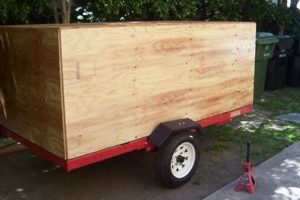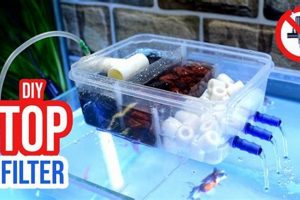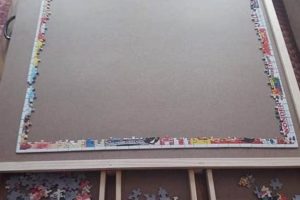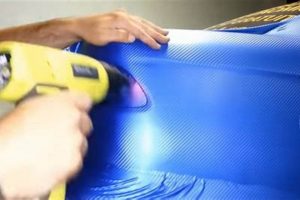A do-it-yourself approach to a space dedicated to washing and drying clothes involves homeowners undertaking the design, construction, and organization of this area themselves, rather than hiring professional contractors. This can range from minor cosmetic upgrades, such as painting and adding shelving, to complete renovations that include plumbing and electrical work. For example, a homeowner might install new cabinets, a folding counter, and enhanced lighting in their existing wash area.
This method of creating a functional wash area offers several advantages, including cost savings, personalization, and the satisfaction of completing a home improvement project. Historically, wash spaces were often relegated to basements or back porches. Now, however, there is increased emphasis on creating efficient and aesthetically pleasing rooms that integrate seamlessly with the rest of the home. Achieving such a goal can raise property value and improve the overall quality of life for the residents.
The following sections will explore specific elements that contribute to a successful implementation of this concept, including planning and design considerations, storage solutions, budget management, and common challenges encountered during the construction process. Understanding these aspects is essential for maximizing the potential of a functional and attractive area for managing household clothing care.
Do-It-Yourself Wash Area Enhancement Strategies
The following provides actionable guidance for optimizing a home wash area through a do-it-yourself methodology, focusing on efficiency, organization, and cost-effectiveness.
Tip 1: Strategic Space Assessment: Initiate the project with a thorough evaluation of the existing area. Measure the dimensions accurately and identify any limitations, such as plumbing locations or structural impediments. This initial assessment informs the design phase and prevents costly errors during construction.
Tip 2: Prioritize Ergonomics: Design the space to minimize physical strain. Raise the washer and dryer on platforms to reduce bending. Position the ironing board and folding surface at a comfortable height to promote efficient workflow and minimize discomfort.
Tip 3: Maximize Vertical Storage: Employ vertical space effectively by installing shelves, cabinets, or a wall-mounted drying rack. This maximizes the usable area in the wash room, particularly in smaller spaces. Consider the load-bearing capacity of walls before installing heavy storage units.
Tip 4: Optimize Lighting: Adequate illumination is crucial for stain removal and sorting laundry. Supplement existing lighting with task lighting, such as under-cabinet lights or adjustable spotlights, to ensure sufficient visibility in all areas of the space.
Tip 5: Implement a Sorting System: Designate specific containers for different types of laundry, such as whites, darks, and delicates. Clear labeling helps prevent accidental mixing of clothes and streamlines the washing process.
Tip 6: Conceal Utilities: Hide unsightly plumbing pipes and appliance connections with strategically placed panels or decorative boxes. This improves the aesthetic appeal of the area while maintaining access for maintenance and repairs.
Tip 7: Enhance Ventilation: Ensure adequate ventilation to prevent moisture buildup, which can lead to mold and mildew growth. Install an exhaust fan or consider implementing measures to improve natural airflow, such as opening a window during and after laundry cycles.
These strategies, when implemented thoughtfully, result in a more functional, organized, and visually appealing wash area, contributing to increased efficiency and overall home value.
The final section will address potential challenges and provide resources for troubleshooting common issues associated with a do-it-yourself wash area project.
1. Budget establishment
The establishment of a realistic budget is a foundational element in any do-it-yourself wash area project. Inadequate financial planning can lead to project abandonment, compromised material quality, or unexpected debt. The budget functions as a roadmap, dictating the scope of the project and influencing decisions regarding materials, fixtures, and the extent of necessary structural modifications. For example, a predetermined budget might necessitate choosing laminate countertops instead of granite or opting for open shelving rather than custom-built cabinets.
Effective budget creation involves several steps. First, a comprehensive inventory of required materials and tools is essential. This includes not only visible elements like paint, flooring, and appliances, but also ancillary items such as fasteners, adhesives, and safety equipment. Labor costs, even in a do-it-yourself context, should be factored in, accounting for the time invested and the potential value of outsourcing specialized tasks like electrical or plumbing work. Contingency funds, typically 10-15% of the total budget, are crucial for addressing unforeseen expenses such as hidden structural damage or price fluctuations in building materials.
In summary, diligent budget establishment is not merely a preliminary step, but an integral component of a successful do-it-yourself wash area project. It mitigates financial risks, enables informed decision-making, and ultimately contributes to the creation of a functional and aesthetically pleasing space within predefined resource constraints. Failure to prioritize this aspect can result in cost overruns and project complications that undermine the intended outcome.
2. Space optimization
Space optimization constitutes a critical element in the design and execution of a do-it-yourself wash area project. Given that these areas are often confined, maximizing the effective utilization of available square footage becomes paramount for functionality and user experience.
- Vertical Storage Integration
The strategic incorporation of vertical storage solutions, such as shelving units and wall-mounted cabinets, effectively expands usable space within a wash room. These systems leverage height to accommodate detergents, cleaning supplies, and folded laundry, thereby minimizing clutter on countertops and floors. Implementing adjustable shelving allows for customization based on specific storage requirements.
- Multifunctional Furniture Selection
Choosing furniture that serves multiple purposes enhances the efficiency of the space. Examples include folding ironing boards that can be stored away when not in use, or hampers with integrated shelving for additional storage. Such multifunctional items reduce the footprint occupied by individual pieces and streamline workflow.
- Optimized Layout Design
Careful consideration of the layout is essential for efficient workf
low. Placing the washing machine and dryer in close proximity minimizes movement during the transfer of clothes. A strategically positioned folding area adjacent to the dryer streamlines the process. Clear pathways and unobstructed access to all appliances and storage units are also vital for safety and ease of use. - Underutilized Space Reclamation
Identifying and repurposing underutilized areas, such as the space above the washing machine or the area beneath a sink, can significantly increase storage capacity. Custom-built shelving or pull-out organizers can transform these spaces into functional storage zones for smaller items, maximizing the overall utility of the wash area.
These space optimization strategies, when implemented thoughtfully, result in a more functional, organized, and visually appealing wash area. By effectively maximizing the available space, homeowners can create a wash space that is both efficient and aesthetically integrated with the rest of the home.
3. Efficient layouts
The design of efficient layouts is a cornerstone of a successful do-it-yourself wash area project. The arrangement of appliances, storage, and workspaces directly impacts usability and workflow. A poorly planned layout can result in wasted space, increased physical strain, and decreased productivity. Conversely, a well-designed layout optimizes movement, reduces clutter, and enhances the overall experience of using the space. For example, a layout that positions the washing machine and dryer adjacent to a folding counter and storage shelves streamlines the process of washing, drying, folding, and storing clothes. This arrangement minimizes unnecessary steps and reduces the potential for clutter accumulation.
Considerations for an efficient layout extend beyond the placement of major appliances. Adequate clearance space around these appliances is crucial for safe and easy access. An unobstructed pathway between the washer and dryer prevents tripping hazards and allows for the comfortable transport of laundry baskets. The strategic placement of lighting fixtures also contributes to an efficient layout. Task lighting focused on the folding and ironing areas ensures sufficient visibility for detailed work. The inclusion of a utility sink, if space allows, adds versatility to the space and facilitates tasks such as pre-treating stains and hand-washing delicate items.
In conclusion, the design of an efficient layout is not merely an aesthetic consideration; it is a functional imperative within a do-it-yourself wash area project. A carefully planned layout maximizes usability, promotes efficiency, and enhances the overall value of the space. Prioritizing layout considerations during the planning phase can significantly improve the long-term satisfaction derived from the wash area. Overlooking this aspect can lead to a space that is both frustrating and inefficient, undermining the goals of the project.
4. Storage solutions
Effective storage solutions are integral to a functional do-it-yourself wash area. Given the often-limited dimensions of these spaces, optimizing storage maximizes usability, minimizes clutter, and enhances the overall aesthetic appeal. Strategic planning and implementation of appropriate storage mechanisms are, therefore, essential components of any successful wash area project.
- Wall-Mounted Shelving
Wall-mounted shelving units represent a versatile storage solution for a do-it-yourself wash area. These units leverage vertical space, accommodating detergents, fabric softeners, and other supplies without consuming valuable floor area. Adjustable shelves allow for customization based on storage needs, and open shelving facilitates easy access to frequently used items.
- Cabinetry Installation
Cabinets, both above and below the washer and dryer, offer concealed storage options for a do-it-yourself wash area. These enclosures protect items from dust and moisture, contributing to a cleaner and more organized environment. Furthermore, the installation of cabinets with integrated features, such as pull-out drawers or adjustable shelves, enhances usability and accessibility.
- Mobile Storage Carts
Mobile storage carts provide a flexible solution for organizing and transporting laundry supplies within a do-it-yourself wash area. These carts can be easily moved to different locations as needed, facilitating tasks such as sorting, folding, and ironing. Carts with multiple tiers or drawers offer versatile storage options for detergents, stain removers, and other essentials.
- Over-the-Door Organizers
Over-the-door organizers represent a space-saving storage solution, particularly in smaller wash areas. These organizers utilize the often-overlooked space behind doors, providing convenient storage for cleaning supplies, ironing accessories, and other small items. Over-the-door organizers are easy to install and offer an affordable way to maximize storage capacity without requiring significant modifications to the existing space.
In conclusion, the strategic implementation of various storage solutions directly contributes to the functionality and organization of a do-it-yourself wash area. By carefully considering the available space, storage needs, and budget, homeowners can create a wash space that is both efficient and aesthetically pleasing. The integration of wall-mounted shelving, cabinetry, mobile carts, and over-the-door organizers optimizes space utilization and enhances the overall usability of the area.
5. Proper ventilation
Adequate ventilation is a non-negotiable element in the construction or renovation of a do-it-yourself wash area. The absence of effective air circulation can precipitate a range of detrimental consequences, impacting both the structural integrity of the space and the health of its occupants.
- Moisture Control and Mold Prevention
The operation of washing machines and dryers inherently generates significant amounts of humidity. Without proper ventilation, this moisture accumulates, creating an environment conducive to mold and mildew growth. Mold proliferation compromises air quality, potentially triggering allergic reactions and respiratory issues. Moreover, it can cause irreversible damage to building materials, necessitating costly remediation efforts.
- Reduction of Odor Buildup
Wash areas are prone to the accumulation of unpleasant odors originating from wet clothing, detergents, and other cleaning agents. Effective ventilation facilitates the dissipation of these odors, ensuring a more sanitary and pleasant environment. This is particularly crucial in enclosed wash areas lacking natural airflow.
- Prevention of Structural Damage
Excessive moisture, resulting from inadequate ventilation, can lead to structural deterioration. Prolonged exposure to humidity weakens wood framing, corrodes metal components, and compromises the integrity of drywall. Implementing effective ventilation strategies minimizes the risk of such damage, extending the lifespan of the structure.
Energy Efficiency Considerations While the primary function of ventilation is to exhaust moisture and odors, it also impacts energy efficiency. The installation of a properly sized exhaust fan, coupled with appropriate insulation, can minimize heat loss during colder months. This, in turn, reduces the energy required to maintain a comfortable temperature within the home. Moreover, a well-ventilated space dries clothes more efficiently, reducing the energy consumption of the dryer.
These facets underscore the critical role of ventilation in the design and maintenance of a do-it-yourself wash area. By prioritizing adequate air circulation, homeowners can mitigate the risks associated with moisture buildup, odor accumulation, and structural damage, while simultaneously enhancing energy efficiency and promoting a healthier living environment. The investment in proper ventilation is, therefore, a prudent measure with long-term benefits.
6. Durable materials
The selection of durable materials is paramount in the construction of a do-it-yourself wash area, impacting longevity, maintenance requirements, and the overall return on investment. The wash area, by its nature, is subject to moisture, chemical exposure from detergents and cleaning agents, and potential physical impact from laundry handling. Therefore, materials must withstand these conditions to ensure a lasting and functional space.
- Flooring Resistance
Flooring in a wash area is susceptible to water damage and staining. Durable options include porcelain or ceramic tile, which are waterproof and resistant to staining. Luxury vinyl plank (LVP) is another suitable choice, offering water resistance and ease of installation. Concrete, when properly sealed, provides a durable and modern option. Each of these materials offers varying degrees of resistance to moisture and impact, influencing the long-term maintenance and replacement costs of the floor. The choice of material should align with the anticipated usage intensity and budget constraints.
- Countertop Integrity
Countertops in a wash area are exposed to detergents, bleach, and other cleaning chemicals, as well as potential water spills. Quartz and solid surface countertops offer resistance to staining and chemical damage. Laminate provides a cost-effective option, but it is susceptible to water damage if not properly sealed at seams. Butcher block can be used, but requires regular sealing to prevent moisture absorption and bacterial growth. The selection should balance aesthetic considerations with the functional demands of a wash environment.
- Cabinetry Construction
Cabinetry is a critical component of storage in a wash area, and durable construction is essential to withstand humidity and frequent use. Solid wood cabinets offer strength and longevity, but can be susceptible to warping in high-humidity environments. Plywood cabinets provide a more stable alternative, resisting warping while offering comparable strength. Particleboard cabinets are a budget-friendly option, but are prone to water damage and swelling. The internal hardware, such as hinges and drawer slides, should also be of high quality to ensure smooth and reliable operation.
- Plumbing Fixture Resilience
Plumbing fixtures, including faucets and sinks, are exposed to constant water flow and potential chemical exposure. Stainless steel and solid brass fixtures offer corrosion resistance and durability. Plastic fixtures are less expensive, but may be prone to cracking and discoloration over time. The choice of fixture should consider the expected frequency of use and the potential for exposure to harsh chemicals. High-quality plumbing fixtures contribute to the long-term functionality and aesthetic appeal of the wash area.
The strategic selection of durable materials is a fundamental aspect of a successful do-it-yourself wash area project. Prioritizing materials that withstand moisture, chemical exposure, and physical impact minimizes the need for repairs and replacements, ultimately reducing the total cost of ownership. Moreover, durable materials contribute to a more aesthetically pleasing and functional space that enhances the value and enjoyment of the home.
7. Lighting design
Lighting design is a critical, often underestimated, element in a do-it-yourself wash area project. Inadequate illumination compromises safety and efficiency, impacting the ability to discern stains, sort clothing accurately, and navigate the space without incident. Poor lighting can lead to eye strain, impacting both visual acuity and user comfort. Conversely, a well-designed lighting scheme enhances functionality, improves the overall ambiance, and contributes to a safer and more pleasant work environment. This is particularly crucial in a space often relegated to basements or small interior rooms where natural light is limited or non-existent. A poorly lit wash room can transform a necessary chore into a daunting task, directly affecting the frequency and quality of laundry management.
Practical application of effective wash area lighting involves a multi-layered approach. General ambient lighting, achieved through overhead fixtures such as recessed lights or a ceiling-mounted fixture, provides overall illumination. Task lighting, focused on specific work areas like the washing machine, dryer, folding table, and ironing board, offers targeted illumination for detail-oriented tasks. This can be achieved through under-cabinet lighting, adjustable spotlights, or pendant lights. A supplementary light source, such as a natural-spectrum bulb, can assist in accurate stain detection. Furthermore, consider the placement of light switches and outlets to ensure convenient access and minimize the need for extension cords. A well-lit wash room can also improve the perceived size of the area, making it feel more open and less cramped.
In conclusion, incorporating a thoughtfully planned lighting design into a do-it-yourself wash area project is not merely an aesthetic consideration, but a functional necessity. It enhances safety, improves efficiency, and contributes to a more pleasant and productive laundry experience. Challenges may include balancing budget constraints with the need for adequate illumination and selecting fixtures appropriate for a humid environment. However, the long-term benefits of a well-lit wash room far outweigh these challenges, contributing to a more functional and enjoyable home environment.
Frequently Asked Questions
The following addresses common inquiries concerning the planning, execution, and maintenance of a do-it-yourself wash area, providing factual and concise responses.
Question 1: What are the primary considerations when planning a do-it-yourself wash area project?
Initial considerations encompass space assessment, budget establishment, and desired functionality. Accurately measuring the available space, establishing a realistic budget, and defining the specific needs and features of the wash area are crucial initial steps.
Question 2: How can costs be effectively managed in a do-it-yourself wash area project?
Cost management strategies include comparing material prices across multiple vendors, repurposing existing materials where feasible, and performing labor-intensive tasks personally. A detailed budget spreadsh
eet, tracking all expenses, is essential.
Question 3: What constitutes appropriate flooring material for a wash area?
Suitable flooring materials for wash areas exhibit resistance to moisture, staining, and impact. Recommended options include ceramic tile, porcelain tile, luxury vinyl plank (LVP), and sealed concrete.
Question 4: How does one ensure adequate ventilation in a do-it-yourself wash area?
Adequate ventilation is achieved through the installation of an exhaust fan vented to the exterior of the building. The exhaust fan’s capacity should be commensurate with the size of the wash area. Regular cleaning of the fan is necessary.
Question 5: What are common storage solutions for maximizing space in a wash area?
Effective storage solutions include wall-mounted shelving, overhead cabinets, rolling storage carts, and over-the-door organizers. Prioritize vertical storage to optimize limited floor space.
Question 6: What are the potential challenges encountered in a do-it-yourself wash area project?
Potential challenges include unexpected plumbing or electrical issues, unforeseen structural modifications, and difficulty adhering to the established budget. Contingency planning is essential to mitigate these risks.
Diligent planning, adherence to safety protocols, and thorough research are paramount for a successful wash area project. Addressing these common inquiries facilitates a more informed approach.
The subsequent section will explore advanced techniques and specialized considerations within the realm of do-it-yourself wash areas.
Conclusion
This exploration has illuminated the multifaceted considerations inherent in creating a functional and aesthetically pleasing “diy laundry room”. From initial space assessment and meticulous budget establishment to strategic layout design, durable material selection, and critical ventilation implementation, each element contributes significantly to the success and longevity of the project. Effective storage solutions and thoughtful lighting design further enhance usability and safety within this essential home space.
The creation of a “diy laundry room” is not merely a cosmetic upgrade, but a strategic investment in home efficiency and value. By carefully considering the presented guidelines and adhering to sound construction practices, homeowners can transform a mundane utility area into a well-organized and functional space that enhances the daily lives of the occupants and potentially increases property value. Thoughtful planning and execution are the keys to maximizing the benefits of this endeavor.







